Upper Dolpo To Mustang Trek Overview
Listen up, adventurers—this isn’t your average Nepal trek. The Upper Dolpo to Mustang trek is a 26-day beast through some of the most untamed, forbidden-feeling corners of the Himalayas, where yaks outnumber people and the landscapes look like Mars got into a fistfight with Tibet. Think crumbling medieval villages, hidden Buddhist monasteries, and trails so remote you’ll half-expect a yeti to photobomb your selfie. This isn’t just a hike; it’s a full-blown expedition into Nepal’s last truly wild frontier. Still with me? Good. Because if you’re the type who thinks the Annapurna Circuit is "too mainstream," buckle up—this one’s for you.
Let me tell you about the kind of trek that doesn't just change your Instagram feed - it rewires your entire idea of adventure. This isn't some guided nature walk where porters carry your espresso machine. This is 26 days of raw, unfiltered Himalayan reality where every sunrise brings new ways to question your life choices while simultaneously blowing your mind.
The trail kicks your heart from day one. You'll start in dusty lowlands where the air still feels generous, but don't get comfortable. Soon you're grinding up switchbacks so steep they should come with a therapist, your boots sliding on shale that sounds like breaking pottery. Then comes your first real test - Kang La Pass at 5,380m where the altitude hits like a truck and the wind tries to steal your hat right off your head. But when you finally crest that ridge and see the entire Annapurna range spread out like some divine marble countertop? That's when you get it.
Phoksundo Lake will ruin all other lakes for you forever. That impossible blue isn't some camera trick - it's glacial melt so pure you can drink straight from it (and you will, because your water ran out hours ago). The surrounding cliffs look like God took a knife to the earth and just kept carving. You'll camp nearby listening to the lake's eerie silence, broken only by the occasional rockfall echoing across the valley.
Then there's Shey Gompa, where time forgot to keep moving. The monastery clings to the mountainside like some ancient spaceship, its prayer flags so weathered they're more memory than fabric. The local monks might invite you in for butter tea that tastes like liquid campfire - drink it anyway. This is where you realize you're not just passing through these landscapes, you're being allowed to witness them.
The final stretch into Mustang feels like entering a lost kingdom. Lo Manthang's maze of narrow alleys and whitewashed houses hasn't changed much since the 15th century. You'll duck through doorways built for people much shorter than modern tourists, eat tsampa until you dream in barley flour, and maybe - if you're lucky - catch a glimpse of the famous "sky caves" carved impossibly high into the cliffs.
This trek doesn't care about your comfort. Some nights you'll sleep in stone huts heated by yak dung. Some days the trail disappears entirely and you just follow the smell of smoke from the next village. But that's the magic - there's no Disney version of this experience. What you get is the real, unfiltered Himalayas in all their brutal, breathtaking glory.
Pro Tip: Your feet will swell at altitude. Buy boots a full size bigger than normal and break them in until they feel like second skin. And pack moleskin - when your blisters get blisters, you'll thank me.
Listen up, nature nerds. This trek isn't some curated botanical garden tour - it's a 26-day slap in the face from Mother Nature herself. Forget those pretty postcards. Here's the unfiltered truth about what actually grows, crawls and dominates this insane route.
First Week: The Jungle Beatdown
You'll start sweating through valleys so lush they feel prehistoric. We're talking walnut trees with trunks wider than your tent, and wild cannabis plants tall enough to hide a yak (not that I looked). The air hums with giant bumblebees dive-bombing rhododendron blooms - these aren't your grandma's garden flowers, but angry pink explosions dripping nectar. Pro tip: Watch where you pee - those aren't regular nettles, but Himalayan giants that'll leave your legs burning for days.
Mid-Trek: The Ghost Forests
Around 3,500m, things get weird. The trees start twisting into nightmare shapes from the wind, like nature's middle finger to Instagram aesthetics. This is blue sheep territory - except they're not blue, and honestly look more like grumpy mountain goats with an attitude problem. One morning I woke to find a whole herd staring at me like I was the weird one for sleeping in a tent.
High Altitude: Where Plants Give Up
Above 4,000m, vegetation basically says "screw this" and quits. You'll find cushion plants - these crazy survivalists that grow sideways like they're trying to escape the wind. The real showstoppers? Glacier lilies punching through snow like they've got something to prove. Saw my first snow leopard track here - just paw prints the size of dinner plates leading off a cliff. No cat, just the implication.
Mustang: The Desert That Breaks You
By the time you hit Lo Manthang, you'll be begging for a single weed. This is Mars with prayer flags - just endless dust, howling winds, and the occasional griffon vulture circling like it's taking bets on who quits first. The real miracle? Spotting a Tibetan wolf at dusk - just a shadow that disappears before you can blink.
Wildlife Encounters They Don't Tell You About:
- Pikas everywhere - cute until they keep you awake all night with their squeaky toy barks
- That one Himalayan monal pheasant that followed us for 3 days like some colorful stalker
- Yaks that will absolutely block the trail just to mess with you
Upper Dolpo to Mustang Trek: The Raw, Unfiltered Itinerary
Alright, buckle up. This isn't your typical polished itinerary - this is the real deal, scribbled in my notebook between gasping for air and chugging yak butter tea. Here's exactly how those 26 days will wreck you (in the best possible way).
Kathmandu Chaos (Days 1-2)
You'll land in Kathmandu jet-lagged and wide-eyed, immediately getting scammed by a taxi driver (welcome to Nepal). The "permit preparation day" is really just you trying not to spend all your cash on knockoff North Face gear while officials stamp papers slower than a sloth on Valium. Pro tip: Hit up Boudhanath Stupa at sunset - it's the last peaceful moment you'll get for weeks.
The Approach (Days 3-6)
That sketchy flight to Nepalgunj? Just wait for the Juphal flight - a tin can with wings that drops you onto a dirt strip clinging to a cliff. From there, it's 3 days of "warm-up" hiking through villages where kids will laugh at your struggling. Dunai to Chhepka is all sweaty river valleys, then Sumduwa hits you with your first real climb. My legs still remember those endless stone steps.
Phoksundo Bliss (Days 7-8)
When you finally stumble into Shey Phoksundo Lake, you'll understand why we take a rest day here. That water isn't blue - it's like someone melted a glacier and mixed in liquid gemstones. The local monks might let you ring the ancient bell at the gompa (if you bring chocolate to bribe them). WARNING: The lake's so clear you'll see fish mocking you from 20m down.
The Pain Begins (Days 9-14)
Now the real trek starts. Sallaghari to Nangdala High Camp is where your lungs first realize they're not in Kansas anymore. Crossing Nangdala Pass (5,360m) feels like running a marathon while breathing through a coffee stirrer - but the view of the Tibetan plateau will steal what little breath you have left. Shey Gompa to Namgung is all wind-scoured valleys and prayer flags older than your grandparents.
Cultural Whiplash (Days 15-19)
Saldang to Komash is where you enter another century - medieval villages where they still barter with salt and think smartphones are witchcraft. Yangjer Gumba's golden Buddha watches over valleys so quiet you can hear your own heartbeat. By the time you reach Chharka, you'll be so dusty they might mistake you for a local (until you try to speak).
The Final Gauntlet (Days 20-24)
Yak Kharka to Ghok Pass is the trek's cruel joke - just when you think you're tough, the Himalayas laugh and throw another 5,000m pass at you. Sangda to Phalek is all bone-dry canyons that feel like walking through a kiln. When you finally drag yourself into Jomsom, you'll kiss the ground (then immediately regret it because everything's covered in donkey poop).
The Escape (Days 25-26)
That Jomsom-Pokhara flight? You'll spend it pressed against the window like a kid, staring at Annapurna's peaks you somehow survived near. Back in Kathmandu, you'll wander Thamel in a daze, jumping at every gust of wind (old trekking reflexes) and craving dal bhat like it's crack.
Real Talk Takeaways:
- Day 11 (Nangdala Pass) will make you question all your life choices
- The "rest day" at Phoksundo is really just your body begging for mercy
- That flight from Jomsom feels like returning from another planet
- You'll develop a lifelong hatred/love affair with stone stairs
This isn't a vacation - it's a 26-day boot camp for your soul where the Himalayas test everything you've got. Still interested? Then you're either my kind of crazy or you didn't read this closely enough. Either way, I'll see you on the trail - I'll be the one cursing at my backpack while secretly loving every minute.
Upper Dolpo to Mustang Trek: 10 Highlights That'll Make You Question Your Life Choices
"Let's cut the brochure crap—this isn't a walk, it's a 26-day Himalayan gut check. I came for the mountain views and left with scabbed knees, a newfound respect for yak herders, and core memories that hit harder than altitude sickness. These aren't just highlights—they're the raw, unfiltered moments that'll tattoo themselves on your brain when you're dumb enough (or brave enough) to take on Upper Dolpo to Mustang."
Here’s the real thing you’ll brag about forever – straight from my battered trekking journal:
- Phoksundo Lake’s Witchcraft Waters (3,600m)
That insane turquoise isn’t Photoshop – it’s glacial melt so clear you’ll see your exhausted reflection mocking you from 15m down. Pro tip: The west shore’s waterfall plunge pool is so cold it’ll shock your sweat away. - Nangdala Pass Gauntlet (5,360m)
Where the air’s thinner than your patience, and the prayer flags flap like a standing ovation when you finally puke-and-stumble over the top. Worth it for the Tibetan plateau views that look like a sandstorm froze mid-air. - Shey Gompa’s Ancient Vibes (4,500m)
This 800-year-old monastery clings to cliffs like a wisdom tooth. Time your visit for morning puja – the monks’ chants mix with yak bells in a soundtrack you’ll hear in dreams later. - Blue Sheep Standoffs
Not blue. Not sheep. Just dozens of these grumpy mountain goats staring you down on trails so narrow you’ll suck in your gut to let them pass. Best spotted near Namgung Gompa’s crumbling walls. - Lo Manthang’s Medieval Maze (3,800m)
The walled city’s alleys smell like centuries of yak butter and dust. Get lost purposefully – that’s how you find the hidden thangka painting workshops where artists grind minerals into paint. - Ghok Pass’s Cruel Joke (5,095m)
The trek’s “final exam” – a soul-crushing climb rewarded with Dhaulagiri’s fangs gleaming like broken glass. Your legs will hate you. Your camera roll won’t. - Chharka’s Hot Springs
- After 19 days of grime, these natural scalding pools feel like heaven’s mouthwash. Locals swear the minerals heal blisters – I just know it’s the first time you’ll feel clean.
- Saldang’s Time-Warp (3,900m)
Village kids play with 100-year-old carved wooden tops while grandmas spin wool like it’s 1523. The barley beer here kicks harder than the altitude. - Jomsom’s Victory Donuts
That first post-trek pastry at German Bakery tastes like Michelin-starred gold after weeks of dal bhat. Fight me. - The Flight Out
Staring out the plane window at the Kali Gandaki Gorge you just crossed on foot – realizing you’re somehow already nostalgic for the pain.
Bonus “They Never Mention This” Highlight:
Full moon at Yak Kharka – where the Himalayas glow like radioactive cheese and you’ll finally understand why Tibetans call this “the roof of the gods.”
When to Trek Upper Dolpo to Mustang: A Season-by-Season Reality Check
The Himalayas don't care about your vacation plans. This high-altitude desert trek shifts dramatically with the seasons - here's what actually happens on the ground when the weather changes:
Autumn (September-November) - The Post-Monsoon Gift
Crisp air slaps you awake each morning as the first sunlight hits the trail. By 10AM, you'll be peeling layers while crossing ancient suspension bridges over rivers finally calm after monsoon. Afternoon clouds roll in like clockwork, but rarely ruin the show. At night, expect frost on your tent by 8PM - that's when teahouse owners break out the raksi (local moonshine) to warm frozen fingers.
Spring (March-May) - When the Mountains Wake Up
The real action starts at 3,000m where rhododendrons explode in neon pinks and reds. Lower valleys buzz with bees drunk on pollen, while higher up, melting snow creates impromptu waterfalls across the trail. Pack gaiters - the afternoon slushfest is real. Mustang's dust storms typically hit around 4PM, reducing visibility to 20 meters and coating everything in fine orange powder.
Winter (December-February) - Silence and Suffering
Frozen streams mean no water access after 3PM - fill up early. The "trail" often disappears under snowdrifts, requiring careful navigation. Shey Gompa's monks retreat to lower villages, leaving the monastery empty except for the occasional fox seeking shelter. On clear nights, the cold is so intense it feels like the stars are burning through your tent.
Monsoon (June-August) - Just Don't
Landslides regularly wipe out sections near Dunai. Leeches in the lower forests attack in swarms. Phoksundo Lake turns murky with runoff, losing its famous blue. The few trekkers foolish enough to attempt this season often get stranded for days when flights can't land in Juphal.
The Local Truth
Dolpo shepherds say the mountains show their true face in late October when the first snow dusts the high passes but hasn't closed them yet. Mustang's apple harvest season (early September) means fresh pies in Kagbeni if you time it right.
Food & Shelter on the Upper Dolpo to Mustang Trek: The Real Deal
Let's cut through the brochure nonsense and talk about what really keeps you going during those 26 brutal days. This isn't some curated Himalayan cafe tour - it's survival dining and shelters that make you appreciate every scrap of warmth. Here's exactly what to expect, mile by grueling mile.
The Teahouse Hierarchy of Needs
Down in the lower valleys (Dunai to Chhepka), you'll find what passes for "luxury" on this route - basic wooden lodges with actual doors that close (most of the way). The beds are plywood platforms with foam pads thinner than your guidebook's maps, but after 8 hours of hiking, they feel like memory foam. Some even have solar showers that work... when the sun's been out.
As you climb toward Phoksundo Lake, things get real. The stone teahouses at Ringmo village look like they've been standing since medieval times - because they have. Expect smoky yak-dung stoves, blankets that smell like generations of trekkers, and windows that rattle when the wind screams down from the passes. At Shey Gompa, the "beds" are basically shelves carved into rock walls - cozy if you're a mountain goat.
By the time you hit Mustang's high desert, you're sleeping in literal mud-brick caves with doors made from repurposed apple crates. The upside? These ancient structures stay surprisingly warm once the dung fires get going. The downside? You'll wake up with a fine coating of dust in every crevice - consider it Himalayan exfoliation.
The Food: Carb Loading for Survival
Breakfast is where hopes and dreams collide with reality. That "pancake" on your plate? More like a frisbee made of flour and regrets. The porridge could double as wallpaper paste, but drown it in honey (local bees work harder than your porter) and it goes down okay. Instant coffee comes in two varieties: brown water or motor oil strength - choose wisely.
Lunch is all about speed - you want something that won't slow you down for afternoon climbs. The trekker's trifecta: garlic soup (altitude armor), chapati wraps (edible napkins), and Snickers bars (the real MVP). Pro tip: Time your stops before 1PM when the solar ovens actually work.
Dinner is where dal bhat becomes your religion. That steaming pile of lentils and rice isn't just food - it's unlimited fuel, electrolytes, and comfort in one dented tin plate. The chicken version is mythical (like spotting a snow leopard), but the potato variation in Mustang will make you weep with joy. Momos are the wild card - sometimes bursting with juice, sometimes drier than the surrounding landscape.
High Altitude Reality Checks
Above 4,000m, the dining experience gets... creative. That "pizza" on the menu? More like naan with ketchup. Boiling water takes forever because physics hates you - your tea will be lukewarm at best. Menus shrink faster than your appetite as supplies dwindle - "apple pie" might mean a single dried slice floating in sugar water.
Hygiene standards follow their own logic. The kitchen might be a smoke-blackened cave where the cook uses the same knife for vegetables, meat, and trimming his fingernails. Yet somehow, the momos won't kill you (probably). Your stomach will rebel around day 10 - this is normal. The garlic soup isn't just folk medicine; it's your new best friend.
Pro Tips From the Trenches
- Pack electrolyte tabs like your life depends on it (because at 5,000m, it might)
- Carry beef jerky or nuts - when the menu says "Tibetan bread," it means fried dough bricks
- The cleanest lodges are usually run by families with kids in school uniforms
- Learn to love raksi (local moonshine) - it's the only thing that warms you from the inside after Ghok Pass
- Tip in snacks rather than cash at remote stops - those Snickers bars are better than currency
When you finally stumble into Jomsom, that first hot shower will reveal tan lines mapping every strap and wrinkle in your gear. That "German Bakery" apple strudel will taste like the pinnacle of human achievement. And weirdly, within a week, you'll miss the simplicity of dal bhat under a sky full of Himalayan stars.
🧾 Trekking Permits & Regulations Guide for Upper Dolpo to Mustang Trek
If you’re planning the Upper Dolpo to Mustang Trek, brace yourself—not just for the landscapes, but for the permit paperwork too. This route passes through two major restricted areas: Upper Dolpo and Upper Mustang. That means no TIMS card, but you’ll need special permits, and you must trek with a registered guide through a licensed agency. Solo trekking? Not allowed here. No exceptions.
Here’s what you need to make this dream route happen:
✅ Required Trekking Permits
Upper Dolpo Restricted Area Permit (RAP)
- Where to get it: Department of Immigration, Kathmandu (via a registered trekking agency)
- Cost: USD $500 per person for the first 10 days; then USD $50 per person per additional day
Notes: Mandatory to have at least 2 trekkers in a group and a licensed guide
Upper Mustang Restricted Area Permit (RAP)
- Where to get it: Department of Immigration, Kathmandu (via a registered trekking agency)
- Cost: USD $500 per person for 10 days; then USD $50 per additional day
Notes: Same rules as Dolpo — no solo trekkers, guide compulsory
Shey Phoksundo National Park Entry Permit
- Where to get it: Nepal Tourism Board, Kathmandu or DNPWC office in Dolpa
- Cost: NPR 3,000 (approx. USD $25) per person
Notes: Needed for entering the Dolpo side of the trek
Annapurna Conservation Area Permit (ACAP)
- Where to get it: Nepal Tourism Board, Kathmandu or Pokhara
- Cost: NPR 3,000 (approx. USD $25) per person
Notes: Required once you enter the Mustang region (ACAP zone)
Upper Dolpo to Mustang Trek: The Brutal Truth About Fitness Requirements
Let’s be real—this isn’t a walk in the park. This is 26 days of Himalayan punishment that’ll test your body, mind, and willpower. If you’re still reading, here’s exactly what it takes to survive (and maybe even enjoy) this beast of a trek.
The Fitness Baseline: Can You Actually Do This?
- Legs of Steel (Or At Least Not Noodles)
You’ll be hiking 6-8 hours daily, often on loose scree, steep switchbacks, and knee-crushing descents. If walking up 30 flights of stairs leaves you gasping, start training NOW. - Lungs That Can Handle Thin Air
5 high-altitude passes (Kang La at 5,360m, Ghok at 5,095m, etc.) where oxygen is 40% less than at sea level. If you’ve never been above 3,000m, you have no idea how altitude feels—like breathing through a coffee straw while jogging. - A Back That Can Carry Its Own Weight
Even with porters, you’ll need to haul a 6-8kg daypack with water, snacks, and layers. If your shoulders scream after an hour with a laptop bag, hit the gym.
Daily Reality Check: What Actually Happens
- Day 3 (Dunai to Chhepka): "Easy" warm-up? Nope. 5-6 hours of river valley trails that sneak in relentless ups and downs.
- Day 11 (Nangdala Pass): A 7-hour grind where every step above 5,000m feels like running a marathon.
- Day 21 (Ghok Pass): The "final boss" of the trek—1,000m ascent on loose rock, followed by a quad-busting downhill.
Altitude: The Silent Killer
- Acclimatization isn’t optional. Skip it, and you’ll be puking by Shey Gompa.
- Symptoms don’t care how fit you are: Headaches, nausea, and insomnia hit Olympic athletes too.
- The fix? Slow pace, garlic soup, and Diamox (if your doc approves).
- Training Plan: Get Ready or Get Wrecked
3 Months Before:
- Cardio: Run, hike, or stair-master 4x a week (aim for 1-hour sessions at 70% max effort).
- Legs: Squats, lunges, and step-ups with a loaded backpack (start with 5kg, work up to 10kg).
- Core: Planks and dead bugs—because balancing on scree slopes requires more stability than a tightrope walker.
1 Month Before:
- Weekend hikes with elevation gain (if you live flat, find a stadium and stomp stairs for hours).
- Test your gear—blisters on Day 1 are a rookie mistake.
Who Should NOT Do This Trek?
- "I hike sometimes" folks – This isn’t a casual stroll.
- People with bad knees – The descents will destroy untrained joints.
- Altitude newbies – If you’ve never been above 3,500m, try a shorter trek first.
Final Reality Check
- You will suffer. But the views? Worth every gasp, cramp, and whimper.
- You don’t need to be superhuman—just stubborn enough to keep moving when your legs beg to quit.
Still think you can handle it? Then train hard, pack smart, and get ready for the adventure of a lifetime.
For those seeking an adventurous and immersive experience in one of Nepal’s most remote and picturesque regions, the Upper Dolpo to Mustang Trek is an exceptional choice.
Seeking a shorter but equally enchanting Himalayan adventure? The Upper Mustang Trek offers a rich blend of Tibetan culture, hidden caves, and dramatic desert scenery — all within a more manageable itinerary.
🧭Alternative Tours & Packages
- Premium Upper Mustang Heli Trek
Explore the mystical landscapes of Mustang with a luxurious helicopter-supported trek. This premium package offers stunning aerial views, easy access to remote areas, and comfortable accommodations while immersing you in the ancient Tibetan culture and desert-like terrain. - Upper Mustang Bike Tour
Explore the Forbidden Kingdom on two wheels as you navigate dramatic desert cliffs, ancient Tibetan-style villages, and the Kali Gandaki gorge. This adventurous biking tour offers a thrilling and immersive experience through one of the Himalayas’ most mystic landscapes.
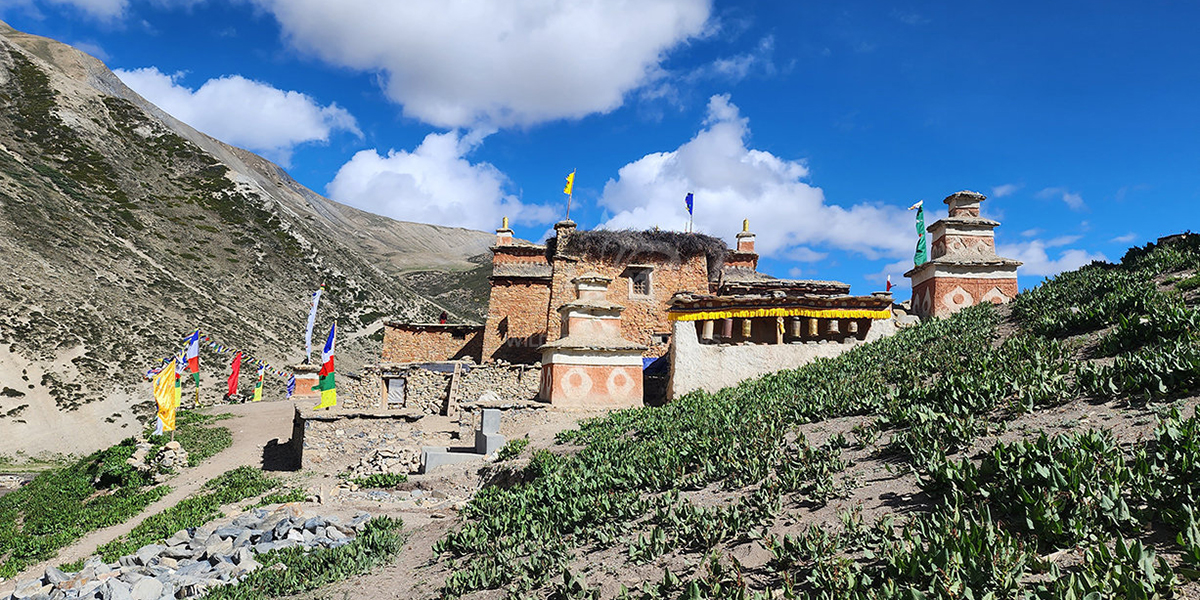
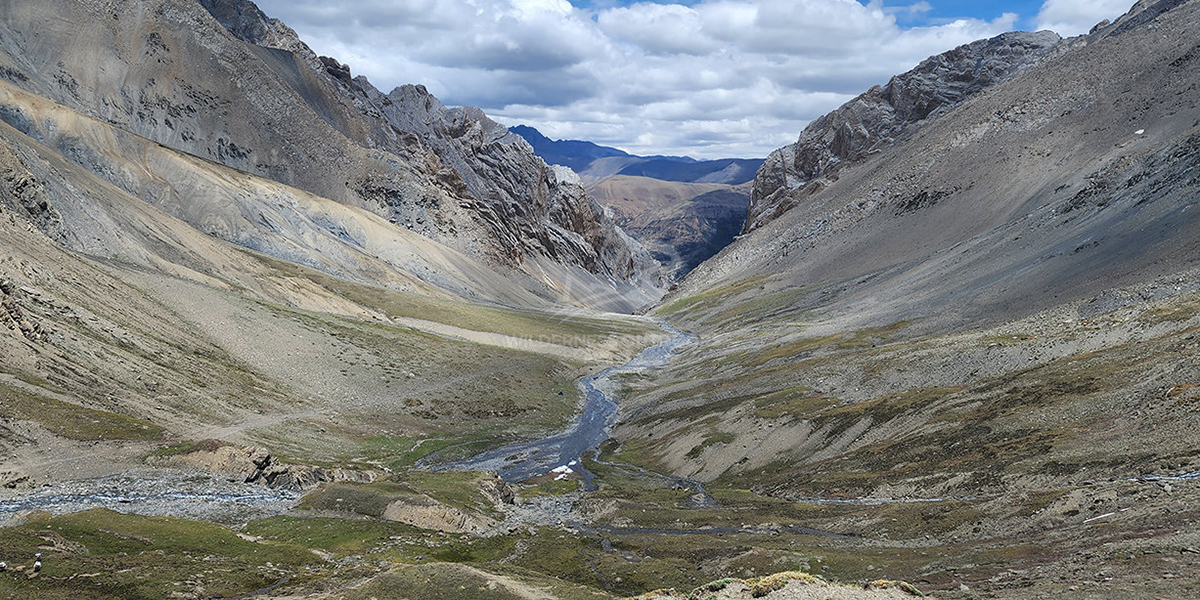
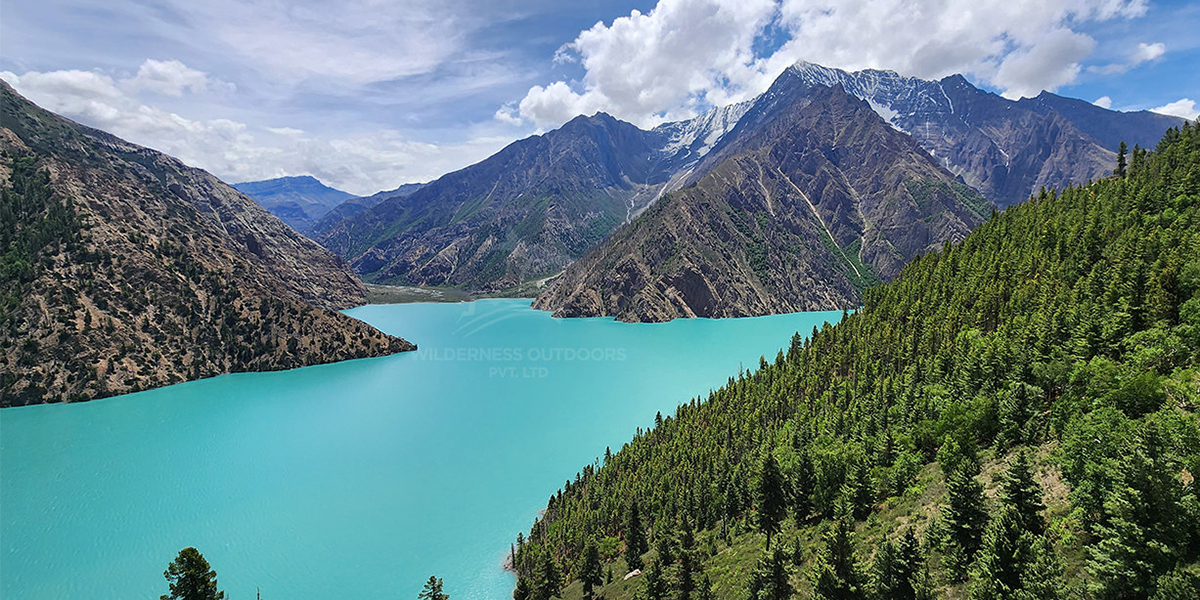
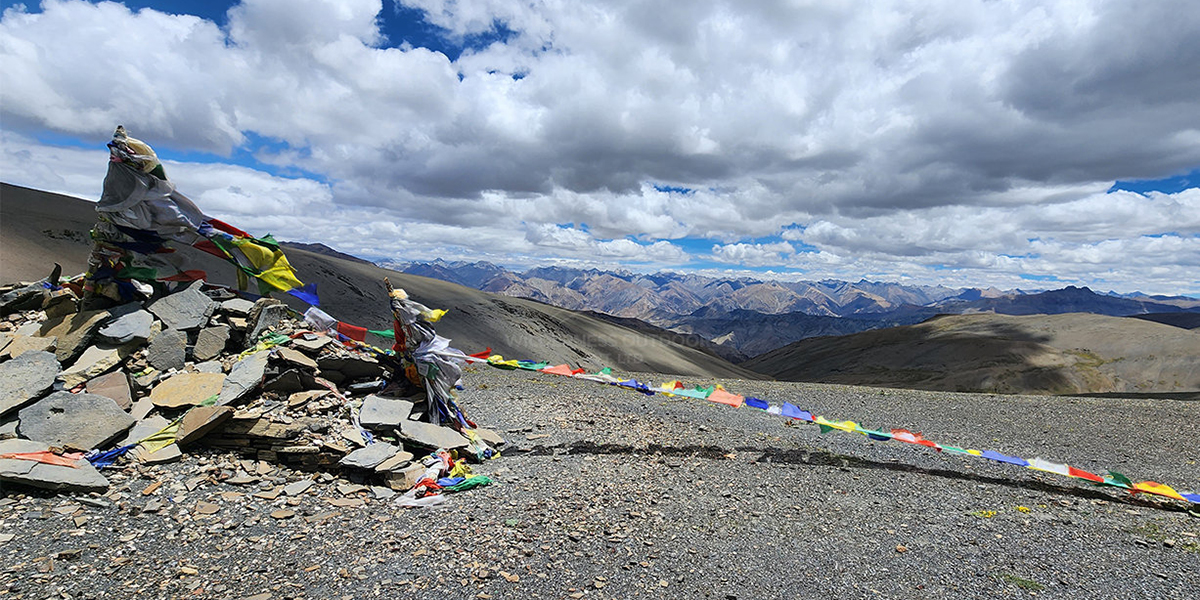
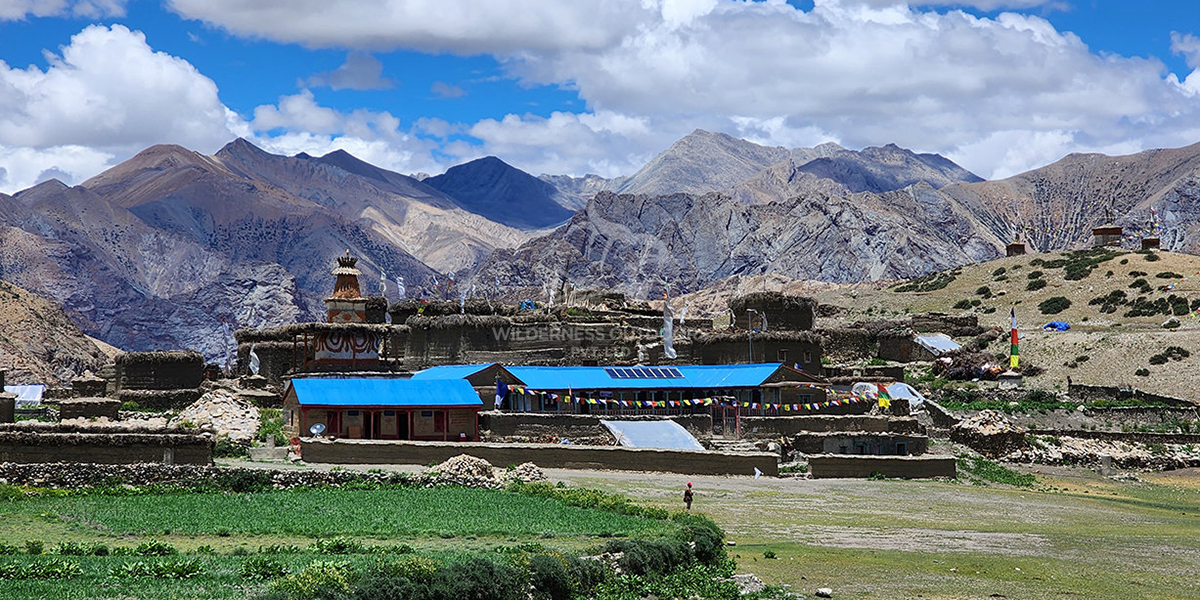


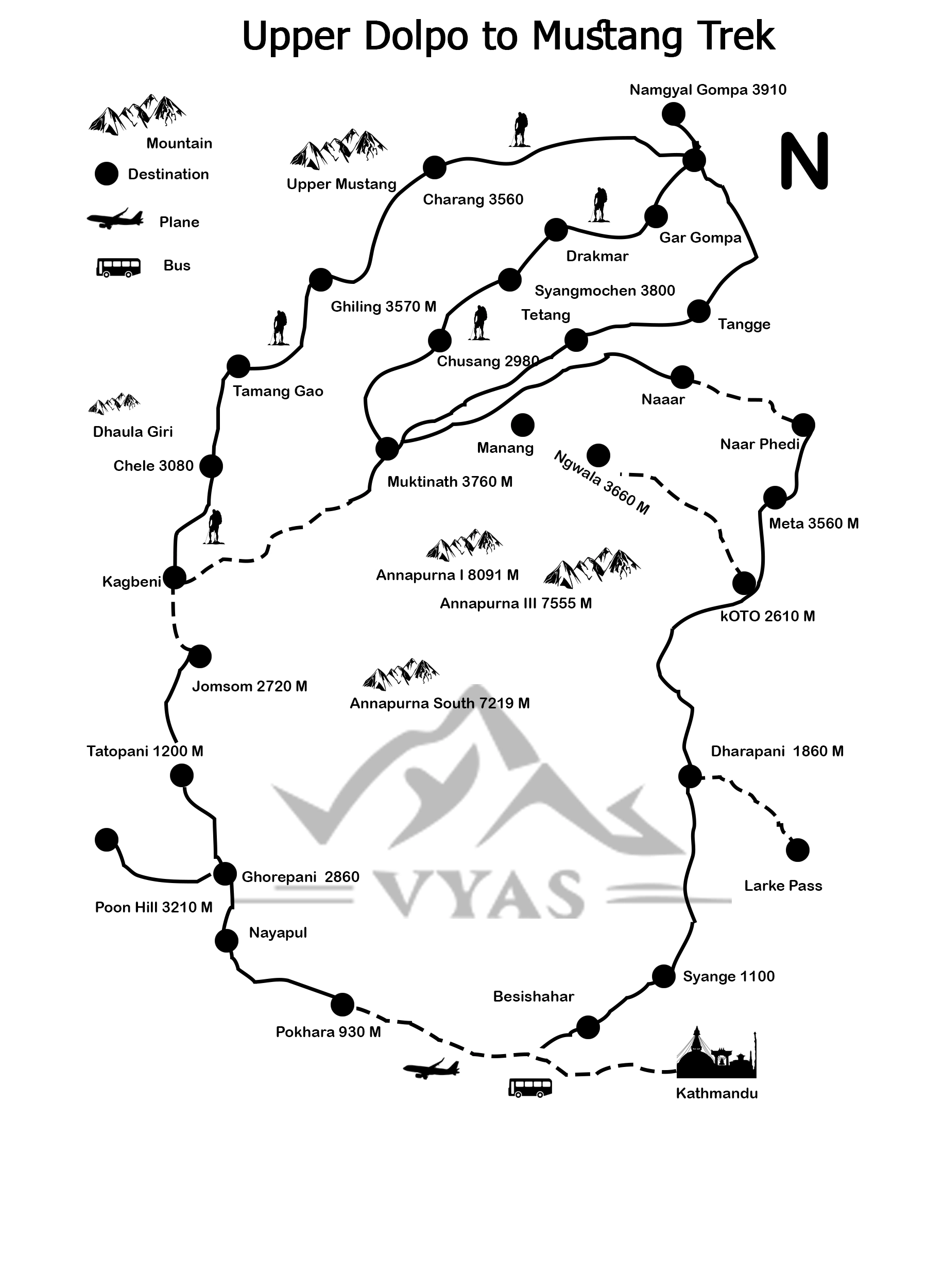






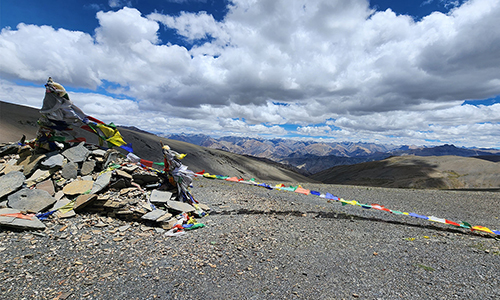

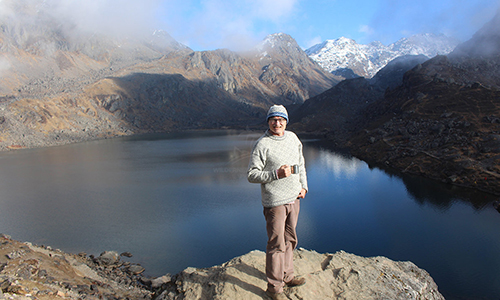


Alexander Hughes
2025-06-16 10:55:21
The Upper Dolpo to Mustang Trek with Vyas Treks Nepal was the most remote and rewarding adventure I’ve ever done. The landscapes were raw and untouched, the culture was incredibly rich, and we barely saw any other trekkers for days. The support team was outstanding—our guide knew the terrain like the back of his hand, and the porters were absolute heroes. A true once-in-a-lifetime trek for seasoned adventurers.